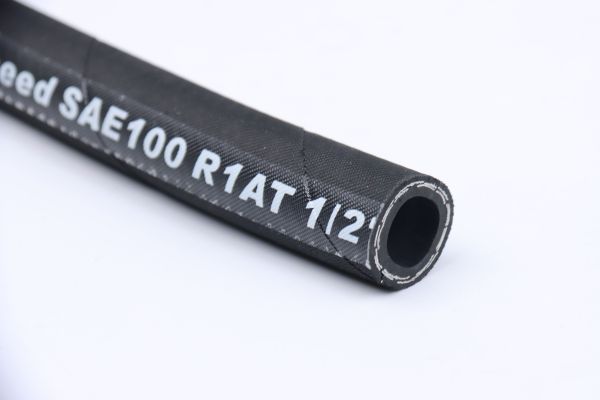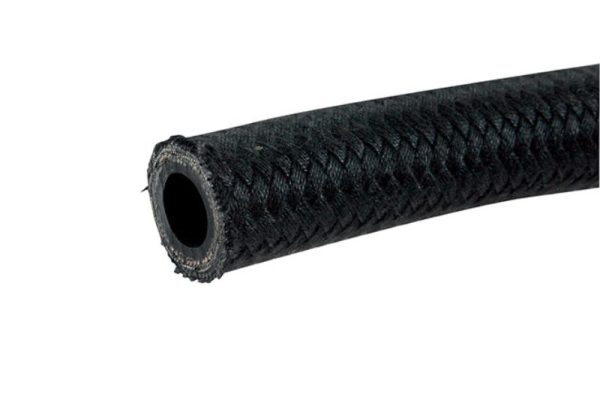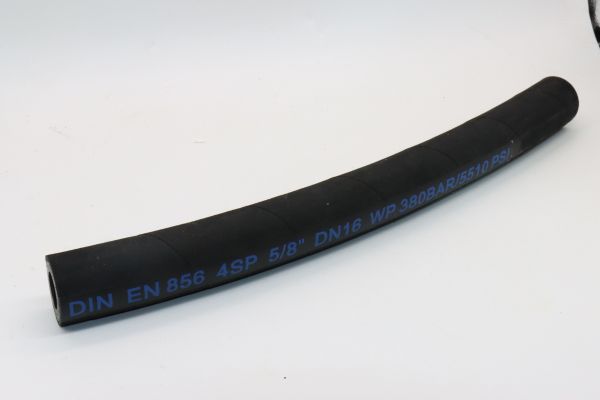In the complex and demanding world of industrial machinery and systems, hydraulic hoses seamlessly transmit fluid power to ensure the smooth operation of machinery. Without hydraulic hoses, the reliability and functionality of countless pieces of equipment would be greatly diminished, resulting in increased downtime and maintenance costs. This article delves into the diverse world of hydraulic hoses, providing an in-depth look at the various types of hydraulic hoses and their specific applications.
Hydraulic hoses come in various types, each designed for specific applications and pressure ranges. Low-pressure hoses, such as SAE 100R4 and 100R6, are used in return and suction lines. Medium-pressure hoses are versatile and commonly used in various machinery. High-pressure hoses, like SAE 100R13 and R15, are built for heavy-duty applications with high-pressure requirements. Thermoplastic hoses, such as SAE 100R7 and R8, offer flexibility and resistance to chemicals, making them suitable for demanding environments. Specialty hoses, including non-conductive, extreme temperature, and abrasion-resistant types, cater to specific industrial needs. Each type is essential for maintaining the efficiency and reliability of hydraulic systems.
The Society of Automotive Engineers (SAE) sets a series of rigorous standards for hydraulic hoses, ranging from SAE 100R1 to SAE 100R18. These standards specify the construction, performance criteria, and testing requirements to ensure hoses deliver reliable and safe performance under various operating conditions. For instance, SAE 100R1 hoses are designed for low to medium pressure hydraulic applications and feature a single braided steel wire reinforcement, while SAE 100R13 and R15 hoses are constructed for high-pressure scenarios with multiple layers of spiral-wound wire reinforcement. Adhering to SAE standards ensures that hoses can withstand specific pressure ratings, temperature ranges, and fluid types, providing peace of mind in their dependability and durability in demanding applications.

Construction: Single steel wire braid
Applications: Used primarily for medium-pressure hydraulic oil delivery in agricultural, construction, and industrial equipment.
Working Pressure: Up to 225 bar (depending on diameter)
Temperature Range: -40°C to +100°C
Features: Excellent abrasion and weather resistance with good flexibility.
Construction: Double steel wire braid
Applications: Suitable for high-pressure hydraulic oil delivery, widely used in construction, mining, and agricultural equipment.
Working Pressure: Up to 400 bar (depending on diameter)
Temperature Range: -40°C to +100°C
Features: High-pressure tolerance with superior abrasion and weather resistance.
Construction: Double fiber braid
Applications: Designed for low-pressure hydraulic oil delivery and return lines, commonly used in industrial machinery and agricultural equipment.
Working Pressure: Up to 88 bar (depending on diameter)
Temperature Range: -40°C to +100°C
Features: Lightweight and highly flexible with excellent bending performance.
Construction: Inner and outer rubber layers with fiber braid and steel wire spiral reinforcement
Applications: Mainly used for low-pressure or suction and return lines, suitable for fuel systems, tanks, and cooling systems.
Working Pressure: Up to 28 bar (depending on diameter)
Temperature Range: -40°C to +100°C
Features: Excellent vacuum and kink resistance.

Construction: Single steel wire braid reinforcement with a textile braided cover
Applications: Used for medium to high-pressure hydraulic oil delivery, commonly found in trucks, industrial, and mobile equipment.
Working Pressure: Up to 210 bar (depending on diameter)
Temperature Range: -40°C to +100°C
Features: Oil and abrasion-resistant with good flexibility.
Construction: Single fiber braid
Applications: Low-pressure hydraulic oil delivery, ideal for agricultural equipment and industrial hydraulic systems.
Working Pressure: Up to 28 bar (depending on diameter)
Temperature Range: -40°C to +100°C
Features: Lightweight with good flexibility.
Construction: Thermoplastic material with fiber braid reinforcement
Applications: Medium-pressure hydraulic and fluid delivery, used in agricultural and industrial equipment.
Working Pressure: Up to 210 bar (depending on diameter)
Temperature Range: -40°C to +93°C
Features: Corrosion and abrasion-resistant, suitable for high and low-temperature environments.
Construction: Thermoplastic material with fiber braid reinforcement
Applications: High-pressure hydraulic oil delivery, widely used in industrial and agricultural equipment.
Working Pressure: Up to 350 bar (depending on diameter)
Temperature Range: -40°C to +93°C
Features: High-pressure tolerance, corrosion resistant, suitable for harsh environments.
Construction: Four layers of spiral steel wire
Applications: Ultra-high-pressure hydraulic systems, suitable for construction, mining, and heavy-duty equipment.
Working Pressure: Up to 420 bar (depending on diameter)
Temperature Range: -40°C to +121°C
Features: Extremely high-pressure tolerance with excellent abrasion and weather resistance.

Construction: Multiple layers of spiral steel wire
Applications: Extremely high-pressure hydraulic systems, used in large machinery and heavy-duty equipment.
Working Pressure: Up to 500 bar (depending on diameter)
Temperature Range: -40°C to +121°C
Features: Highest pressure tolerance, suitable for extreme working environments.
Construction: The SAE J517 100R14 hydraulic hose is constructed with a core tube made of polytetrafluoroethylene (PTFE) or a similar thermoplastic, reinforced with one or more layers of high-strength stainless steel wire braiding.
Applications: It is commonly found in industries such as chemical processing, pharmaceuticals, food and beverage, and aerospace.
Working Pressure: The working pressure for the SAE J517 100R14 hose can vary depending on the diameter, but it is generally capable of withstanding pressures up to 300 bar or more.
Temperature Range: This hose operates effectively within a temperature range of -54°C to +260°C, which is broader than many other types of hydraulic hoses.
Features: Its PTFE core tube provides non-stick properties and minimal friction loss, while the stainless steel reinforcement ensures excellent durability and pressure tolerance.
The International Organization for Standardization (ISO) establishes global standards that promote consistency and quality across hydraulic hose products worldwide. ISO standards cover various aspects of hydraulic hoses, including dimensions, performance, and testing procedures. For example, ISO 18752 outlines the requirements for hoses used in high-pressure hydraulic systems, offering a classification based on performance criteria such as impulse pressure and temperature tolerance. By adhering to ISO standards, manufacturers and users can ensure that hoses meet international quality benchmarks, facilitating easier sourcing and replacement of hoses across different regions and applications.
In the European market, the Deutsches Institut für Normung (DIN) provides a set of stringent guidelines for hydraulic hose quality and performance. DIN standards are highly respected and widely adopted, specifying detailed requirements for hose construction, dimensions, pressure ratings, and testing methodologies. For instance, DIN EN 853 and DIN EN 856 define specifications for braided and spiral-wound hydraulic hoses, respectively, ensuring they can withstand high pressures and harsh operating environments. DIN standards emphasize the importance of robust design and consistent performance, making them crucial for applications in industries such as manufacturing, construction, and heavy machinery. Compliance with DIN standards ensures that hydraulic hoses deliver exceptional durability and reliability, meeting the rigorous demands of European and global markets.
Construction: Single steel wire braid
Applications: Suitable for medium-pressure hydraulic applications in agricultural, construction, and industrial equipment.
Working Pressure: Up to 225 bar (depending on diameter)
Temperature Range: -40°C to +100°C
Features: Offers good flexibility and excellent abrasion and weather resistance.
Construction: Double steel wire braid
Applications: Used for high-pressure hydraulic applications in construction, mining, and industrial equipment.
Working Pressure: Up to 400 bar (depending on diameter)
Temperature Range: -40°C to +100°C
Features: Provides high-pressure tolerance and superior durability in tough conditions.
Construction: Single textile braid
Applications: Ideal for low-pressure hydraulic applications, including return lines and industrial systems.
Working Pressure: Up to 24 bar (depending on diameter)
Temperature Range: -40°C to +100°C
Features: Lightweight and highly flexible, suitable for low-pressure applications.
Construction: Double textile braid
Applications: Used for low to medium-pressure hydraulic applications, including return lines and general industrial applications.
Working Pressure: Up to 80 bar (depending on diameter)
Temperature Range: -40°C to +100°C
Features: Provides enhanced flexibility and good abrasion resistance.

Construction: Four layers of spiral steel wire
Applications: Suitable for very high-pressure hydraulic applications in heavy-duty equipment, including construction and mining machinery.
Working Pressure: Up to 450 bar (depending on diameter)
Temperature Range: -40°C to +100°C
Features: Extremely high-pressure tolerance with excellent abrasion and weather resistance.
Construction: Four layers of spiral steel wire
Applications: Used for ultra-high-pressure hydraulic applications in heavy-duty and industrial equipment.
Working Pressure: Up to 500 bar (depending on diameter)
Temperature Range: -40°C to +100°C
Features: Provides the highest pressure tolerance and durability for extreme working environments.
Low-pressure hoses are integral components in hydraulic systems that operate at minimal pressure. These hoses are specifically designed to handle low-pressure conditions while maintaining efficient fluid conveyance. They are essential in applications such as return lines and suction lines, where the pressure is not as intense but still requires reliable performance.
One of the primary roles of low-pressure hoses is to ensure consistent fluid conveyance. In hydraulic systems, return lines carry fluid back to the reservoir after it has been used in the system, while suction lines draw fluid from the reservoir into the pump. Low-pressure hoses must maintain a steady flow of fluid without collapsing or restricting the flow, which is critical for the smooth operation of the hydraulic system. For example, SAE 100R4 hoses are designed with a textile braid reinforcement that provides sufficient support to prevent hose collapse under low-pressure conditions, ensuring continuous and reliable fluid movement.
The construction of low-pressure hoses is tailored to their specific use cases. SAE 100R4 hoses are constructed with a textile braid reinforcement that offers durability and flexibility, making them suitable for low-pressure, high-temperature operations. This construction allows them to withstand the thermal stresses encountered in various industrial environments, such as in hydraulic oil return lines where temperatures can be high. The textile braid also provides a degree of flexibility, making it easier to route the hoses in tight spaces or around obstacles without compromising their structural integrity.
On the other hand, SAE 100R6 hoses feature a single textile braid reinforcement, making them even more flexible and versatile. This increased flexibility is advantageous in general-purpose low-pressure applications where hoses may need to navigate complex layouts or tight spaces. The construction of SAE 100R6 hoses ensures they can handle low-pressure hydraulic fluids, water, and other compatible fluids, making them suitable for a wide range of industrial applications.
Medium-pressure hoses typically involves one or two layers of braided wire reinforcement, which ensures both durability and flexibility, catering to applications that require this balanced performance.
The construction of medium-pressure hoses is a key factor in their performance. Typically, these hoses feature one or two layers of braided wire reinforcement, which provides the necessary strength to handle moderate pressures while maintaining flexibility. The braided wire reinforcement not only enhances the durability of the hose but also allows it to bend and flex without kinking or collapsing, which is crucial for applications that involve complex routing or movement.
For example, a hose with a single layer of braided wire reinforcement offers a good balance of strength and flexibility, making it suitable for applications where moderate pressure and frequent movement are expected. On the other hand, hoses with two layers of braided wire reinforcement provide added strength and durability, making them ideal for more demanding applications where higher pressure and increased wear and tear are factors.
High-pressure hoses are engineered to handle extreme pressures, making them indispensable for demanding and heavy-duty applications. These hoses are crucial for industries where high-pressure hydraulic systems are used, such as construction, mining, and heavy equipment manufacturing. Examples like SAE 100R13 and SAE 100R15 stand out for their ability to endure significant pressure without sacrificing performance, thanks to their robust construction with multiple layers of spiral-wound wire reinforcement.
High-pressure hoses like SAE 100R13 and SAE 100R15 are constructed with multiple layers of spiral-wound wire reinforcement. This design provides exceptional strength and durability, enabling the hoses to handle extremely high pressures. The spiral-wound wire layers offer superior resistance to pressure surges and mechanical stress, ensuring the hose remains intact and functional under demanding conditions.
SAE 100R13: This type of hose is designed to handle pressures up to 5,000 psi. Its construction includes multiple layers of high-tensile steel wire spirals, providing the necessary reinforcement to withstand high-pressure conditions. The inner tube is typically made from oil-resistant synthetic rubber, while the outer cover is designed to protect against abrasion, weather, and other environmental factors.
SAE 100R15: These hoses are built for even higher pressure capabilities, often exceeding those of SAE 100R13. With an extra layer of wire reinforcement, SAE 100R15 hoses can endure extreme pressures, making them suitable for the most demanding industrial and mobile equipment applications. The construction ensures maximum strength and longevity, even in the harshest operating environments.
Thermoplastic hoses, exemplified by SAE 100R7 and SAE 100R8, bring a host of benefits to hydraulic systems that traditional rubber hoses often cannot match. Their unique properties make them highly suitable for a range of demanding applications, especially where flexibility, weight reduction, and chemical resistance are critical factors.
One of the standout features of thermoplastic hoses is their lightweight nature. Compared to traditional rubber hoses, thermoplastic hoses are significantly lighter, which can lead to easier handling and installation. This weight advantage is particularly beneficial in applications where the hose must be moved frequently or routed through complex configurations. Additionally, the inherent flexibility of thermoplastic material allows these hoses to bend and twist without kinking or collapsing, making them ideal for dynamic applications where movement is constant.
Thermoplastic hoses like SAE 100R7 are well-suited for medium-pressure hydraulic applications. They are commonly used in equipment that requires a balance of flexibility and strength, such as forklifts, aerial lifts, and various types of industrial machinery. The construction of SAE 100R7 hoses includes a thermoplastic inner tube and a synthetic fiber braid reinforcement, providing the necessary strength to handle medium-pressure demands while maintaining flexibility.
For high-pressure applications, SAE 100R8 hoses are the go-to choice. These hoses are designed to withstand higher pressures and are used in more demanding environments, such as in hydraulic tools, injection molding machines, and other heavy-duty equipment. SAE 100R8 hoses feature a thermoplastic inner tube and a high-tensile synthetic fiber braid reinforcement, ensuring they can endure the rigors of high-pressure operations.
Specialty hoses are designed to meet specific requirements beyond standard hydraulic applications. This category includes:
Non-Conductive Hoses: These hoses are engineered for electrical safety, preventing the conduction of electricity, making them ideal for use near electrical equipment or in environments where electrical hazards are a concern.
Extreme Temperature Hoses: Designed to withstand extreme temperatures, both high and low, these hoses are suitable for applications in harsh climates or where thermal resistance is necessary.
Abrasion-Resistant Hoses: Built with robust outer covers to resist wear and tear, these hoses are ideal for environments where they are subject to mechanical damage or rough handling.
Correct sizing is essential for optimal performance in hydraulic systems. This involves accurately measuring the hose’s internal diameter, length, and external diameter to ensure it fits perfectly with the system components. An incorrectly sized hose can lead to insufficient fluid flow, increased pressure drops, and potential system failures. Therefore, precise measurements are crucial for ensuring the hose can handle the required volume and pressure of hydraulic fluid without causing operational issues.
Temperature fluctuations can significantly impact the performance and lifespan of hydraulic hoses. Selecting a hose that can withstand the operating temperature range of the specific application is critical. Hoses exposed to temperatures beyond their design limits can become brittle, crack, or degrade, leading to leaks and failures. It is important to choose hoses made from materials that can resist both high and low temperatures, ensuring consistent performance and longevity in varying environmental conditions.
Different applications require specific types of hydraulic hoses. It is crucial to match the hose’s construction and properties to the intended use. For instance, hoses used in construction equipment need to withstand high pressures and harsh environments, while those used in agricultural machinery may need to handle moderate pressures but with greater flexibility. Understanding the specific demands of the application helps in selecting the right hose that can provide reliable performance and meet the operational requirements.
Compatibility with the hydraulic fluid is vital to prevent chemical degradation of the hose material. Hydraulic systems use various fluids, including petroleum-based, water-based, and synthetic fluids. The hose material must be resistant to the specific type of fluid it will convey to avoid issues such as swelling, softening, or hardening of the hose, which can lead to leaks and system failures. Ensuring fluid compatibility extends the lifespan of the hose and maintains the integrity of the hydraulic system.
The hose must be able to endure the maximum pressure of the hydraulic system without failure. Hydraulic hoses are rated for different pressure levels, and using a hose with an inadequate pressure rating can result in bursts and safety hazards. It is essential to select a hose with a pressure rating that exceeds the system’s maximum operating pressure to ensure safe and reliable operation. This includes considering both the working pressure and any potential pressure spikes or surges that may occur during operation.
In summary, understanding the types, standards, and key factors in choosing hydraulic hoses is crucial for maintaining optimal performance in hydraulic systems. Selecting the right hydraulic hose ensures the efficiency, safety, and longevity of your hydraulic equipment. To achieve enhanced performance and reliability, evaluate your hydraulic systems and consider upgrading to the latest hose technology.
Low-pressure hoses are designed for applications with minimal pressure, typically used in return and suction lines, while high-pressure hoses can withstand extreme pressures and are used in heavy-duty applications such as construction and mining equipment.
Measure the internal diameter, external diameter, and length of the hose to ensure compatibility with your system’s requirements. Correct sizing is essential for optimal fluid flow and system performance.
Hydraulic hoses are typically made from synthetic rubber, thermoplastic, or PTFE (Teflon) with reinforcement layers of braided or spiral-wound wire to provide strength and flexibility.
Hydraulic hoses need to withstand the operating temperature range of the application to prevent degradation, brittleness, or failure due to temperature extremes, ensuring consistent performance and longevity.
No, it is important to ensure the hose material is compatible with the specific hydraulic fluid being used to prevent chemical degradation, which can lead to leaks and system failures.
The replacement frequency depends on the hose’s usage, environmental conditions, and the manufacturer’s recommendations. Regular inspections and maintenance can help identify wear and tear, ensuring timely replacements and preventing unexpected failures.